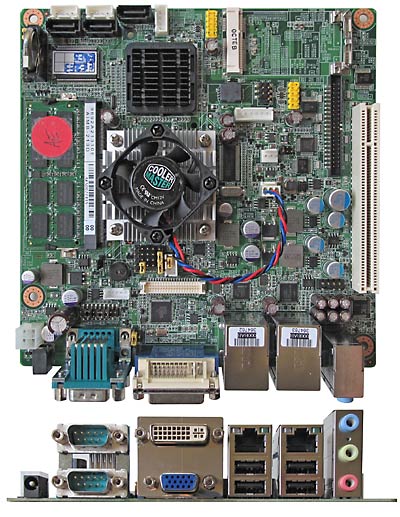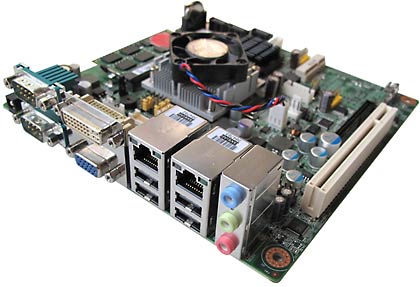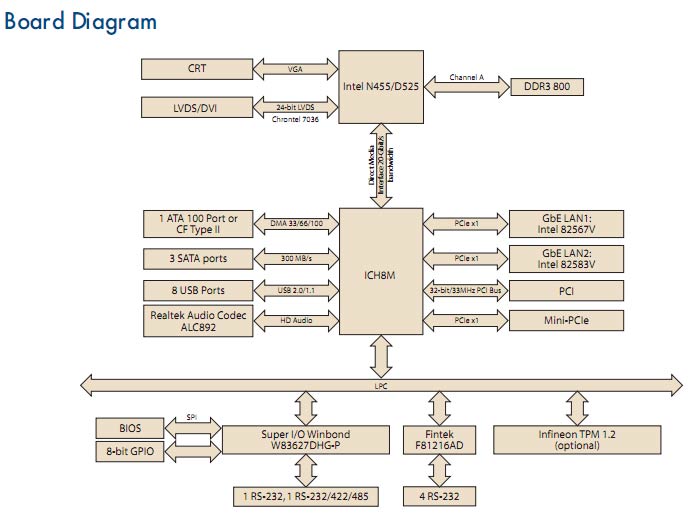|
Advantech AIMB-213
Intel Atom N455 or D525-based Mini-ITX motherboard for industrial and embedded applications
(by Conrad H. Blickenstorfer)
The AIMB-213 is another in Advantech's growing lineup of Mini-ITX motherboards. The company is doing a very commendable job in both making available boards for every new generation of Intel processors as well as subtly differentiating the boards so as to provide a wide selection of capabilities and employing the specific features and strengths of a CPU/chipset combo.
Why supporting so many different boards and board standards? Most people don't spend a lot of time thinking about computer motherboards. They are just inside the PC and do their job. To system integrators, however, the choice of the right motherboard is a big issue. Here are some of the criteria for selecting a motherboard:
- Space considerations
- Processor and chipset technology
- Power requirements
- Interface requirements
- Standards support
As is, there are about two dozen different computer board form factors to choose from. Not all are "full" motherboards. Sometimes, system integrators prefer to use Computer On Module (COM) technology where the generic computing "engine" resides on a separate board that is then plugged into a "carrier" board designed for some specific purpose. This way, system integrators can select the right COM for a complex embedded systems project and then concentrate on their application rather than having to design an entire computer from scratch, saving as much as 80% of the regular development time and cost.
Other times the task at hand can best be filled by a fully integrated conventional motherboard, but there are very detailed requirements and space is an issue. In that case, you'd be looking for a board with just the right functionality that also fits into the allotted space. For example, let's assume an application requires targeted computing power, sufficient memory, support of multiple displays, multiple disks, dual high speed Ethernet ports, and as many USB ports as possible. Noise, heat generation and power consumption are all issues. The system should also be bootable from CompactFlash and the board's footprint shouldn't be larger than about seven by seven inches. There should be a PCI and a mini-PCI expansion slot, but IDE and extensive legacy support isn't necessary. Enter...
The Advantech AIMB-213 Mini-ITX board
A possible answer would be an Intel Atom-powered Mini-ITX board such as the Advantech AIMB-213 shown below. The Mini-ITX form factor has been around since 2001 and specifies a 17 x 17 centimeter (6.7 x 6.7 inches) low-power board. It was originally conceived for entry-level platforms and industrial applications. Unlike some more exotic board types, Mini-ITX board fit into generic computer cases and they use the same screw-mount patterns. Their small size and low power requirements, however, mean that they are perfect for custom applications where a standard PC needs to fit into a small space.
 The Advantech AIMB-213 shown here brings second generation "Pineview" Intel Atom processor to Mini-ITX motherboards. The AIMB-213 supports either the 1.66GHz single core Intel Atom N455 or the 1.8GHz dual core Atom D525. Those two chips got their start as successors to the original Atom N270 that powered tens of millions of netbooks and its less successful N230 sibling targeted at low-end desktops. Intel reduced the chip count from three to two by integrating the graphics and memory controller into the CPU itself. Note, though, that the difference between the two chips is relatively large. The dual core D525 is considerably more powerful, supports twice the memory (4GB of DDR3 RAM instead of the N455's 2GB), graphics clock speed is 400 instead of 200MHz, and TDP (thermal design power) is twice as much, meaning that D525-powered boards need a small CPU fan whereas N455 versions do not. That can make a big difference. The Advantech AIMB-213 shown here brings second generation "Pineview" Intel Atom processor to Mini-ITX motherboards. The AIMB-213 supports either the 1.66GHz single core Intel Atom N455 or the 1.8GHz dual core Atom D525. Those two chips got their start as successors to the original Atom N270 that powered tens of millions of netbooks and its less successful N230 sibling targeted at low-end desktops. Intel reduced the chip count from three to two by integrating the graphics and memory controller into the CPU itself. Note, though, that the difference between the two chips is relatively large. The dual core D525 is considerably more powerful, supports twice the memory (4GB of DDR3 RAM instead of the N455's 2GB), graphics clock speed is 400 instead of 200MHz, and TDP (thermal design power) is twice as much, meaning that D525-powered boards need a small CPU fan whereas N455 versions do not. That can make a big difference.
The board uses an Award BIOS and an embedded Gen3.5+ GFX Core that supports up to 224MB of shared system video RAM. Dual displays are supported via standard rear I/O VGA and DVI connectors, as well as an internal LVDS connector on the board itself. No TV-out here, and no second LVDS port as on the earlier Atom N270-powered AIMB-210 board. If display resolution matters, note that the maximum resolutions vary between output method and even chosen CPU (see specs).
There is a single PCI expansion slot and also a mini-PCIe slot. RAM is provided via two 200-pin SODIMM slots that accommodates up to 2GB of DDR3 800 SDRAM for N455 systems, and up to 4GB for D525 systems. The use of DDR3 offers additional performance enhancement over earlier N270-based boards.
The AIMB-213 board supports dual 10/100/1000Base-T gigabit Ethernet channels, and there are two RJ45 jacks on the rear I/O panel. LAN1 uses an Intel 82567V controller whereas LAN2 uses Intel 82583V.
For disks and other drives, the board offers three 300 MB/s SATA channels. For solid state disk systems, the board also has a single Compact Flash slot for Type I/II CF cards. It is on the bottom side of the board and the system can boot off it. No IDE support here as on the older AIMB-210 board.
The rear I/O panel has four USB 2.0 ports, and two RS232 serial ports, but no more legacy PS/2 ports for keyboard and mouse. What you see on the rear I/O panel, however, is only part of what the AIMB-213 offers. On the board itself are four more USB 2.0 connectors, four additional RS232 serial connectors, the LVDS and Inverter port, as well as an 8-bit Digital I/O (DIO) connector. Also note the notebook-style power jack. It's there because the AIMB-213 offers DC12V support.
Anyone who has ever built their own PC from parts knows about the system panel connector that interacts with buttons and lights on the case or enclosure. It connects to the system power LED, reset button, power button, and hard disk activity light. That's no different on a Mini-ITX board.
The BIOS offers the usual wealth of setup options, both the common sense stuff and the arcane settings that sometimes make all the difference between an optimized system and one that tends to act up.
What's in the box
Here is what Advantech ships when you buy the AIMB-213 for your project:
- AIMB-213 SBC Mini-ITX Main board
- CPU heatsink (only needed for D525
- CD with user manual and all drivers
- Cables/connectors for COM3 and COM4
- 3 SATA HDD cables
- 3 SATA power cables
- I/O shield/panel
- all screws needed for mounting the AIMB-213
Optionally available are various length USB cables, a keyboard/mouse cable, and power adapters.
Why pick the AIMB-213 Mini-ITX SBC?
Who should be interested in the AIMB-213? In short, anyone building systems that have substantial I/O requirements, including strong legacy support, yet must also run quietly and economically. The AIMB-213 certainly fits the bill here as it offers more connectivity than many full-size boards, and fanless operation (N455 boards only) doesn't only mean no noise, but also no electric fan that can fail. Atom-based systems also cost a lot less than Intel Core-based solutions, so if targeted performance at the lowest possible cost is an issue, this board definitely fits the bill.
Keep in mind that as of now, almost all Intel Atom-powered boards, including the AIMB-213, use complementing chipsets that are less future-oriented than the chips themselves. That's generally no big deal for vertical market devices, but potential users should be aware of this limitation.
Of interest to systems integrators: The AIMB-213 supports a number of Advantech's highly regarded software APIs (SMBus, H/W Monitor, Brightness, Watchdog, GPIO) and utilities (BIOS Flash, eSOS, Monitoring, Flash Lock, Embedded Security IS) that can can substantional functionality as well as reduce implementation time.
Below is a schematic of the Advantech AIMB-213:

Mini-ITX has come a long way since the early days of the standard. The Advantech AIMB-213 retains the ITX spirit of a simple, flexible, power-efficient board for a variety of embedded and/or industrial applications where small size and efficiency matter, and it does so with extremely power-efficient Intel Atom processor technology.
Advantech AIMB-213 Specs:
| Type |
Mini-ITX Motherboard
|
| CPU Type |
Intel Atom N455 (single core, 512KB L2 cache) or Atom D525 (dual core, 1MB L2 cache)
|
| Clock Speed |
1.66GHz or 1.8GHz
|
| Thermal Design Power |
6.5 watts (N455), 13 watts (D525)
|
| Chipset |
Intel ICH8M
|
| BIOS |
Award 16 Mbit, SPI
|
| OS |
Windows XP Embedded (Windows Embedded Standard 2009)
|
| Memory |
Max 4GB DDR3 533MHz in 2 204-pin SODIMM sockets |
| Graphics Controller |
Embedded Gen3.5+ GFX Core with 200MHz (N455) or 400MHz (D525) clock |
| VRAM |
Shared system memory up to 224 MB SDRAM |
| LVDS |
Single channel 18/24-bit and up to WXGA (1366 x 768 pixel) with Chrontel 7036 VGA/HDMI/LVDS encoder
|
| DVI |
Supports up to UXGA (1600 x 1200 pixel) @ 60Hz
|
| VGA |
Supports up to SXGA (1400 x 1050 pixel) @ 60Hz for N455, and up to 2048 x 1536 pixel for D525
|
| Dual display |
VGA + DVI, VGA + LVDS, and supports extended and clone modes
|
| Watchdog Timer |
Performs system reset at programmable 1-255sec/min
|
| LAN |
2 x 10/100/1000Base-T (LAN1: Intel 82567V; LAN2: Intel 82583) |
| SATA |
3 x 300 MB/s |
| IDE |
none
|
| SSD |
1 Compact Flash type I/II slot
|
| Expansion |
1 PCI and 1 Mini-PCIe
|
| USB |
8 x USB 2.0 (4 rear panel, 4 on board) |
| Serial |
6 x RS232 (5 RS232, 1 RS232/422/485) |
| Parallel |
none |
| Audio |
3 (Mic-in, Line-out, Line-in) |
| DIO |
8-bit GPIO |
| Size |
170 mm x 170 mm (6.69" x 6.69")
|
| Weight |
14 ounces |
| Operating Temp. |
32 to 140 degrees Fahrenheit |
| Price |
est mid US$200s |
| Datasheet |
Advantech AIMB-213 |
Advantech Corporation
38 Tesla, Suite 100
Irvine, CA 92618
Toll Free: 1-800-866-6008
Ph: 949-789-7178
Fax: 949-789-7179
ECGInfo@advantech.com
www.advantech.com
Advantech Co. Ltd.
No.1, Alley 20, Lane 26, Rueiguang Road
Neihu District, Taipei Taiwan 114, R.O.C.
Tel: 886-2-2792-7818
Fax: 886-2-2794-7301
www.advantech.com
|





 The Advantech AIMB-213 shown here brings second generation "Pineview" Intel Atom processor to Mini-ITX motherboards. The AIMB-213 supports either the 1.66GHz single core Intel Atom N455 or the 1.8GHz dual core Atom D525. Those two chips got their start as successors to the original Atom N270 that powered tens of millions of netbooks and its less successful N230 sibling targeted at low-end desktops. Intel reduced the chip count from three to two by integrating the graphics and memory controller into the CPU itself. Note, though, that the difference between the two chips is relatively large. The dual core D525 is considerably more powerful, supports twice the memory (4GB of DDR3 RAM instead of the N455's 2GB), graphics clock speed is 400 instead of 200MHz, and TDP (thermal design power) is twice as much, meaning that D525-powered boards need a small CPU fan whereas N455 versions do not. That can make a big difference.
The Advantech AIMB-213 shown here brings second generation "Pineview" Intel Atom processor to Mini-ITX motherboards. The AIMB-213 supports either the 1.66GHz single core Intel Atom N455 or the 1.8GHz dual core Atom D525. Those two chips got their start as successors to the original Atom N270 that powered tens of millions of netbooks and its less successful N230 sibling targeted at low-end desktops. Intel reduced the chip count from three to two by integrating the graphics and memory controller into the CPU itself. Note, though, that the difference between the two chips is relatively large. The dual core D525 is considerably more powerful, supports twice the memory (4GB of DDR3 RAM instead of the N455's 2GB), graphics clock speed is 400 instead of 200MHz, and TDP (thermal design power) is twice as much, meaning that D525-powered boards need a small CPU fan whereas N455 versions do not. That can make a big difference.

